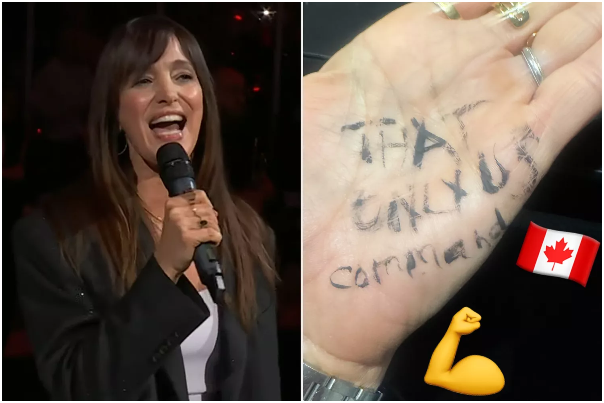1. Introduction: Chantal Kreviazuk’s Protest During the Hockey Game
In an unexpected act of defiance, Canadian singer Chantal Kreviazuk altered the lyrics of Canada’s national anthem, “O Canada,” during a 2025 international hockey game between Canada and the United States. This alteration was a protest against the remarks made by former U.S. President Donald Trump, who suggested in a 2025 speech that Canada could become the 51st state of the United States. Kreviazuk’s choice to change the lyrics was not merely a personal statement but a public protest aimed at highlighting the risks of political power abuse and questioning the integrity of national sovereignty.
The performance took place amidst an international sporting event, where anthem renditions are typically revered for their ceremonial importance. However, Kreviazuk’s decision to use this platform as a tool for political protest turned heads both in the arena and on social media, igniting a widespread conversation about the role of artists in political activism.

2. The Incident: A Bold Change in Lyrics
During her performance of “O Canada,” Kreviazuk deviated from the traditional lyrics, singing “true patriot love that only us command,” instead of the familiar line, “true patriot love in all of us command.” The modified lyric was a pointed response to Trump’s rhetoric about Canada becoming part of the United States, a sentiment that stirred up anger and concern among many Canadians.
Her choice of words was not arbitrary but rather a direct challenge to the idea of American dominance and interference in Canadian politics. The modified lyric seemed to assert Canada’s autonomy and independence, rejecting any notion of subordination to a foreign power. Kreviazuk’s act drew attention not only because it was an impromptu change in the anthem but also because it occurred in the context of a high-profile international event, where national pride and unity are typically on display.
While some attendees at the game responded with boos, others expressed support for the singer’s stance, highlighting the controversial nature of her protest and the polarized reactions to it. Kreviazuk’s performance would go on to spark debates on freedom of expression, national identity, and the intersection of art and activism.
3. The Political Context: Trump’s Remarks and Canada’s Sovereignty
The catalyst for Kreviazuk’s protest was former U.S. President Donald Trump’s remarks suggesting that Canada could become the 51st state of the United States. This statement, made during a 2025 campaign speech, ignited a storm of criticism and concern within Canada. Many saw it as an attempt by Trump to undermine the sovereignty of the country, a sentiment that echoed past concerns about American political interference.
For Canadians, the notion of being absorbed into the U.S. is a deeply uncomfortable one. Canada has long prided itself on its distinct national identity, its own political system, and its unique relationship with the world. Trump’s comments, which some viewed as casually dismissive of Canadian independence, were seen as an affront to that identity.
Kreviazuk, who has always been an outspoken advocate for social justice and human rights, was not the only Canadian public figure to respond to Trump’s remarks. However, her decision to use the national anthem—a symbol of Canada’s unity and independence—as a platform for her protest made her action particularly significant. Her decision to engage with a cultural symbol in this way spoke volumes about her commitment to standing up against what she perceived as a threat to Canadian sovereignty.
4. The Reaction: Mixed Responses to Kreviazuk’s Protest
Kreviazuk’s anthem performance garnered a mixed reaction from the public. In the stadium, there were boos, with some spectators clearly displeased by her altered lyrics. This kind of backlash is common when artists and public figures engage in political acts, especially when it involves a national symbol like the anthem. The response was a testament to the polarized political climate in North America, where debates about nationalism, identity, and foreign influence continue to be highly charged.
However, on social media, Kreviazuk’s actions were met with widespread support. Many praised her for using her platform as an artist to take a stand against political rhetoric they viewed as disrespectful and threatening to Canadian sovereignty. For others, Kreviazuk’s protest was a brave act of defiance, reminding people of the power of artistic expression in challenging political norms.
Not everyone agreed with Kreviazuk’s decision, but her act undeniably opened up a conversation about the intersection of patriotism, politics, and art. This dialogue was particularly timely, given the ongoing debates surrounding nationalism and global politics, with many asking whether the notion of a national anthem should be reserved solely for expressions of unity or whether it can serve as a vehicle for political commentary.
5. The Broader Implications: Art, Activism, and National Identity
Chantal Kreviazuk’s protest raised important questions about the role of artists in political activism. Throughout history, musicians, actors, and other creatives have used their platforms to challenge the status quo, whether it’s advocating for civil rights, gender equality, or political reform. Kreviazuk’s protest fits within this broader tradition of artists using their craft to engage with social and political issues.
The protest also shed light on the complexities of national identity in a globalized world. Canada, often considered a peaceful, progressive nation, has always struggled with balancing its unique identity with its proximity to the United States, a country that wields significant global influence. Kreviazuk’s protest forced a reconsideration of what it means to be Canadian in a time when national borders and identities are increasingly fluid.
Moreover, Kreviazuk’s use of the national anthem, a song deeply embedded in Canadian culture, as a medium for protest demonstrated how powerful cultural symbols can be. It reminded audiences that anthems and flags, while traditionally seen as representations of national unity, can also be used to critique or resist the very systems they represent.
The incident highlighted the evolving role of artists in political discourse, illustrating how individuals in the entertainment industry can use their platforms to influence public conversations and challenge political systems. For Kreviazuk, this protest was not just about standing up for Canadian sovereignty but also about using her voice to remind others of the importance of standing up for one’s values, even when it’s uncomfortable or unpopular.
From: Doublejoydesigns
